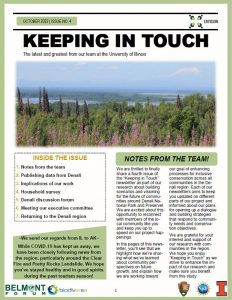Team members Dana Johnson and Devin Goodson presented findings from their research in Denali at the International Association for Society and Natural Resources (IASNR) Virtual Conference that was held virtually from June 20th – June 24th. This annual conference is hosted by IASNR, the flagship organization for applied and interdisciplinary social science research pertaining to environmental and natural resource management issues.
Dana Johnson presented findings from her thesis research that focused on understanding how Denali residents are visioning for the future in the face of climate change. Climate change impacts in Denali are manifesting as observed changes such as alterations to wildlife populations, forest fire regimes, and tourism opportunities. Dana drew from data generated through a discrete choice experiment part of a residential survey to better understand how residents are prioritizing their futures in the face of these changes. She also evaluated respondents’ willingness-to-donate a portion of their Alaska Permanent Fund Dividend to hypothetically offset the costs for their preferred futures. Findings indicated that residents expressed preferences for increasing moose populations and acres managed for fire. However, respondents preferred a future with less off-season tourism growth and were not willing to pay a large amount for these preferred future scenarios. Dana analyzed how preferences varied based on attitudes toward off-season tourism, fire management, moose populations, and the Alaska Permanent Fund to better understand variation in responses. Results showed that preferences were more pronounced based on attitudes. Interestingly, those with strong attitudes toward off-season tourism preferred more growth in the future, while those with weak attitudes toward this feature preferred futures with less off-season tourism growth. Because decisions about the future of Denali will involve difficult tradeoffs, these findings lay groundwork for decision-makers seeking to better incorporate multiple perspectives into future land management.
Meanwhile, Devin Goodson presented findings from his research about the relationship between trust and perceived inclusivity for public land management agencies and local stakeholder. Drawing from survey administered to residents of Alaska, Devin used latent variable modeling to test whether four dimensions of trust (dispositional trust, trust in the federal government, shared values, and moral competency) and information sources that respondents used to learn about protected area management positively influenced perceived inclusivity. Findings showed that residents in Alaska held low levels of dispositional trust, trust toward federal land management agencies, and moral competency. They also did not believe that agencies shared their values pertaining to protected area management. Moral competency, or the belief that agencies adhere to a moral code, was the primary driver of perceived inclusivity among survey respondents, alongside learning sources rooted in professional, community, or environmental advocate exchanges (e.g., government officials, friends, and family environmental groups). These findings are helpful for land management agencies seeking to improve stakeholder perceptions of inclusivity by communicating their sound decisions through information channels.

